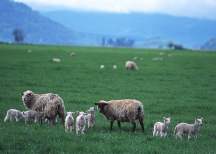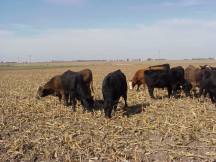Week 4
Roughages |
 |
 |
Instructions for listening to audio clips
- Download the QuickTime
Player to listen to the audio files.
- Read the QuickTime
Instructions for installation help.
- Download the RealPlayer to listen to the audio files
- Instructions are on the RealPlayer download page
Pasture Forages
Text Transcript
Follow along with the audio...
- In U.S.
- Significant feedstuff in animal production
- Figure 8.11 – Percentage of land per county as pasture or rangeland
in 1987 Census of Ag
(Click on photo for larger image)

- Effectiveness of management
- Measured via forage and animal production per unit of land
- In U.S. industries
- Economically significant to beef cattle, dairy cattle, sheep,
and horse industries
- Beef cattle
- Primarily in cow-calf and stocker operations
- Dairy cattle
- Limited for lactating cows
- High nutrient requirements
- Limited land area
- More often for dry-cows and heifers
- Sheep
- Significant source of feed
- Pasture: an area of land with forage grown for animal consumption
via grazing
- Classification
- Cultivated or seeded or introduced and native pasture
- Figure 7-4 on page 132 of the text – Cultivated or introduced
and native pasture regions of U.S.
- Cultivated or seeded
- Greater than 20” rainfall per year or irrigated
- Examples include pastures of Midwest, South, East, and irrigated
and higher rainfall areas in West
- Figure 8.12 – Sheep grazing cultivated pasture

- Native
- Less than 20” of rainfall per year
- Native species
- Not introduced and existed for period of time
- In general, nutritional value and yield of cultivated pastures higher
than native pastures
- Result of forage species and management
- Additional classification
- Permanent
- Used for many years
- In general, most profitable use of land
- Majority of rangelands
- Semi-permanent
- Used for number of years
- Component of crop rotation program
- Temporary and supplemental
- Used for a short period of time
- Often include annual species
- Pasture and range forages in forage system
- Advantages
- Reduced feed cost
- Reduced cost of facilities
- Potential for relatively consistent feedstuff of high nutritional
value
- Improved animal health
- Productive means to use land
- Disadvantages
- Potential loss in revenue compared to alternative crops
- Potential for labor intensive animal management
- Nutritional value of forages depends on environmental and soil
conditions
- Yield and nutritional value
- Factors
- Plant species
- Environmental and soil conditions
- Stage of maturity
- Grazing management
- Focus on factors specific to pasture systems
- Grazing management
- Controls timing and amount of forage grazed to prevent
- Decrease in number, yield, and nutritional value of favorable
species
- Increase in number of unfavorable species
- Increase in soil erosion
- Classifications of systems
- Continuous
- Uninterrupted grazing throughout grazing season
- Compared to rotation
- Lower stocking rate
- Variable stocking rate throughout season
- Larger pastures
- Times of adequate yield and nutritional value, potential for
productivity as rotation
- Advantages
- Lower fencing and watering costs
- Lower labor costs
- Less knowledge of forage management
- Disadvantages
- Variable stocking rate may be issue
- Difficult to manage forage species
- More difficult to harvest and store excess
- Supplementation required to compensate for deficits
- Intermittent (i.e. rotation)
- Rotation: two or more pastures grazed and rested in planned
sequence
- Primary factor is time
- Grazing and rest of forage
- Determined by forage growth and consumption
- Promote forage nutritional value and yield over time
- In less productive periods, rotation systems are more productive
- Advantages
- Increased yield and nutritional value of forage
- Improved stand persistence
- Facilitates removal of excess forage
- Increased carrying capacity of land
- Promotes equal defoliation
- Reduced incidence of animal disease
- Disadvantages
- Higher capital costs
- Higher labor costs
- More knowledge of forage management
- Example: intensive rotation grazing
- Additional forages as pasture forages
- Rape and kale
- Beets and turnips
- Cereal grains
- Grown as forage
- Winter pastures
- Crop residues
- Include stover, chaff, straw, stalkage, and husklage
- Figure 8.13 – Cattle grazing corn crop residue

- Grazed by animals with lower nutrient requirements
- Supplementation with protein and various microminerals
|
 |
 |
|



